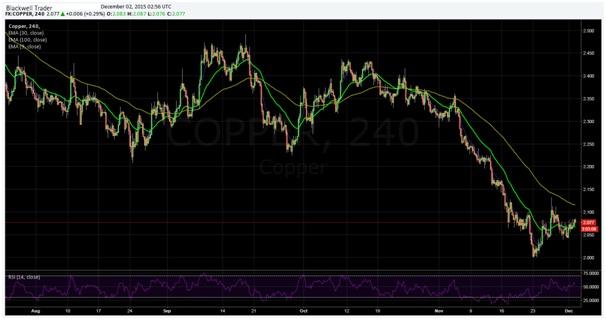2015 has been a relatively down year for copper prices as a combination of slow growth in supply and diminished demand have ravished the commodity. However, despite a relatively static level of supply, prices continue to decline and many are now asking what lays ahead for the industrial metal.
Over the past year, copper bulls have continued to point towards a rebalancing of equilibrium for the metal and the fact that significantly lower prices would eventually cause some mines to shutter their operations. However, 2015 has seen copper prices decline over 20%, whilst supply has actually seen a small increase. Subsequently, global copper prices have remained under significant pressure and the implications of the current over-supply are likely to remain in place for the near future.
In fact, the potential for an imminent increase in supply growth is a significant concern to copper markets. During the copper boom period, large CAPEX programs were undertaken with the expectation of expanding demand. These capital investments are now nearing fruition and could place a significant strain on an already over-supplied market. Based on the current known CAPEX programs, there is potential for at least another 1.4mtpa to enter the market by the end of 2017.
Much of the modelling undertaken within the copper industry has presupposed that this additional supply would be absorbed by growing Chinese demand into 2017. However, given the recent concerning growth indicators emanating from China that assumption must be questioned. This is an especially prescient point given the economic transition that is occurring within the Asian powerhouse’s domestic industries towards more service based endeavours. Although that pivot is likely to take the better part of a decade, growth in copper demand from China is most definitely not assured.
In fact, modelling undertaken by Goldman Sachs points to an increasing divergence between supply and demand. Despite evidence that some rebalancing is occurring within inventory stocks and the lack of visible refined metal, much of the stock is currently being held back in concentrate and SRB inventories. This means that those often underreported stockpiles will continue to grow as global macroeconomic and inflationary conditions remain lack lustre.
In conclusion, growing supply capacity will continue to put copper prices under pressure despite the potential for moderate gains in demand. In addition, much of the current pricing modelling is predicated upon a strong Q4 result from China, which I possess little conviction in. Subsequently, I disregard many of the current analyst opinions pointing to a pricing range around the $4,800/t level by years end. Instead, given the likely depth of the Chinese domestic slow down, coupled with additional productive capacity, my modelling points towards pricing around $4,000/t by the close of Q1, 2016.
Risk Warning: Any form of trading or investment carries a high level of risk to your capital and you should only trade with money you can afford to lose. The information and strategies contained herein may not be suitable for all investors, so please ensure that you fully understand the risks involved and you are advised to seek independent advice from a registered financial advisor. The advice on this website is general in nature and does not take into account your objectives, financial situation or needs. You should consider whether the advice is suitable for you and your personal circumstances. The information in this article is not intended for residents of New Zealand and use by any person in any country or jurisdiction where such distribution or use would be contrary to local law or regulation. Knight Review is not a registered financial advisor and in no way intends to provide specific advice to you in any form whatsoever and provide no financial products or services for sale. As always, please take the time to consult with a registered financial advisor in your jurisdiction for a consideration of your specific circumstances.
Recommended Content
Editors’ Picks
EUR/USD clings to gains above 1.0750 after US data

EUR/USD manages to hold in positive territory above 1.0750 despite retreating from the fresh multi-week high it set above 1.0800 earlier in the day. The US Dollar struggles to find demand following the weaker-than-expected NFP data.
GBP/USD declines below 1.2550 following NFP-inspired upsurge

GBP/USD struggles to preserve its bullish momentum and trades below 1.2550 in the American session. Earlier in the day, the disappointing April jobs report from the US triggered a USD selloff and allowed the pair to reach multi-week highs above 1.2600.
Gold struggles to hold above $2,300 despite falling US yields

Gold stays on the back foot below $2,300 in the American session on Friday. The benchmark 10-year US Treasury bond yield stays in negative territory below 4.6% after weak US data but the improving risk mood doesn't allow XAU/USD to gain traction.
Bitcoin Weekly Forecast: Should you buy BTC here? Premium

Bitcoin (BTC) price shows signs of a potential reversal but lacks confirmation, which has divided the investor community into two – those who are buying the dips and those who are expecting a further correction.
Week ahead – BoE and RBA decisions headline a calm week

Bank of England meets on Thursday, unlikely to signal rate cuts. Reserve Bank of Australia could maintain a higher-for-longer stance. Elsewhere, Bank of Japan releases summary of opinions.
